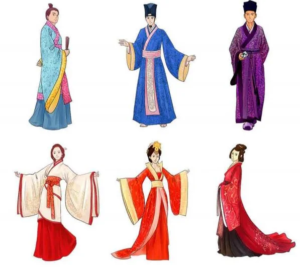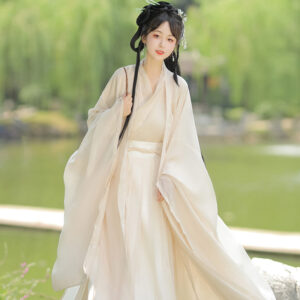

Embroidery in ancient Hanfu showcased status and wealth, involved unique techniques, and reflected rich cultural symbolism. This art form was not merely decorative; it served as a powerful indicator of social hierarchy and personal identity within the context of traditional Chinese society.Embroidery in Hanfu garments varied significantly between different social classes, with intricate designs and luxurious materials reserved for the elite while commoners wore simpler, more practical embroidery. This disparity highlights the cultural values and artistic heritage embedded in the fabric of Hanfu attire.
| Category | Details |
|---|---|
| Material | Silk, gold, silver threads |
| Techniques | Forbidden stitch, various embroidery styles |
| Symbolism | Dragons (power), phoenixes (virtue), flowers (luck) |
| Social Classes | Imperial (extravagant designs), commoners (simple motifs) |
| Historical Context | Shang Dynasty to Song Dynasty, each era contributing to the evolution of embroidery styles |
The Role of Embroidery in Social Stratification
Embroidery served as a visual representation of social status in ancient China. The complexity and quality of embroidery directly correlated with the wearer’s position within society. For instance, emperors and high-ranking officials donned garments adorned with intricate designs made from gold and silver threads, signifying their immense wealth and power. These luxurious materials were costly and rare, making them exclusive to the upper echelons of society.In contrast, common people had access only to simpler embroidery techniques. Their garments typically featured less expensive silk threads and depicted everyday themes such as flowers or animals. These designs were not just for aesthetic appeal but also conveyed wishes for good fortune and prosperity. The subdued colors used in commoners’ embroidery adhered to societal norms that reserved bright hues for the elite.
Evolution of Embroidery Techniques
The history of embroidery in Hanfu can be traced back to the Shang Dynasty (1600–1046 BC), where artisans began exploring basic techniques for decorative purposes. Over time, these techniques evolved significantly, particularly during the Han Dynasty (206 BC – 220 AD), which marked a transformative period for embroidery.During this era, artisans introduced color into their work, enhancing the visual appeal of Hanfu garments. The use of a wider palette of silk threads allowed for more vibrant designs. As embroidery techniques advanced through subsequent dynasties such as the Tang (618–907 AD) and Song (960–1279 AD), artisans began incorporating foreign motifs into their work, reflecting cultural exchanges facilitated by the Silk Road.
Symbolism Embedded in Embroidery
Each motif and pattern used in Hanfu embroidery carries profound cultural significance. For example:
- Dragons: Often associated with power and strength, dragons are prevalent in imperial garments. They symbolize good luck and are frequently depicted alongside clouds or waves.
- Phoenixes: Representing high virtue and grace, phoenixes embody the union of yin and yang. Their intricate designs reflect meticulous craftsmanship.
- Natural Motifs: Common themes like flowers or animals often symbolize wishes for prosperity or good fortune.
These symbols were not only decorative but also served as a means of conveying deeper meanings rooted in Chinese mythology and cultural beliefs.
The Influence of Dynastic Changes on Embroidery
As China transitioned through various dynasties, the styles and techniques of embroidery adapted to reflect contemporary cultural values.
- Tang Dynasty: Known for its cultural richness, this period welcomed foreign influences into embroidery. The complexity and vibrancy of designs flourished during this time.
- Song Dynasty: This era focused on refining techniques further, elevating embroidery to new heights of sophistication. The attention to detail became paramount as artisans sought to perfect their craft.
Practical Uses of Embroidered Hanfu
Beyond its aesthetic appeal, embroidery served practical purposes in daily life. For commoners, embroidered elements often reinforced clothing, extending its longevity during times when resources were scarce. This functionality highlights the ingenuity of lower-class artisans who adapted their skills to meet both practical needs and societal expectations.
Embroidered Hanfu in Rituals and Celebrations
Embroidered Hanfu played a significant role during traditional Chinese festivals such as the Lunar New Year or Mid-Autumn Festival. Specific garments adorned with auspicious symbols were worn to attract good fortune and health during these celebrations.Garments featuring dragons or phoenixes were particularly favored due to their associations with prosperity and harmony. The act of wearing such embroidered clothing during rituals underscored the importance placed on symbolism within Chinese culture.
Regional Variations in Embroidery Styles
Different regions across China developed unique styles of embroidery that reflected local customs and traditions.
- Southern Regions: Known for their vibrant colors and intricate patterns, southern embroidery often featured floral motifs that symbolized beauty and prosperity.
- Northern Regions: In contrast, northern styles tended to be more subdued but emphasized geometric patterns that conveyed strength and stability.
These regional differences illustrate how local cultures influenced the broader narrative surrounding Hanfu embroidery.
Modern Interpretations of Ancient Techniques
In contemporary society, there has been a resurgence of interest in traditional Hanfu attire, including its intricate embroidery. Modern artisans are reviving ancient techniques while infusing them with contemporary aesthetics. This blending of old and new allows for a reimagining of cultural heritage that resonates with younger generations.
Conclusion: The Enduring Legacy of Embroidery in Hanfu
The legacy of embroidery in ancient Hanfu is a testament to its role as a powerful symbol within Chinese culture. From representing social status to embodying deep-rooted cultural values, embroidery has left an indelible mark on the fabric of history. As interest in traditional attire continues to grow today, the significance of these intricate designs remains relevant, connecting past traditions with modern expressions.This exploration into how embroidery was used in ancient Hanfu reveals not only its artistic value but also its profound impact on social dynamics throughout Chinese history. As we continue to celebrate this rich heritage, it is essential to recognize the stories woven into each stitch—stories that reflect resilience, creativity, and an enduring connection to cultural identity.
Share this post
Recent Posts


What were the key features of Hanfu during the Tang Dynasty?

How did Hanfu styles vary during different Chinese dynasties?

What accessories are typically worn with Hanfu?

How do you choose the right Hanfu for different seasons?

Newsletter
Popular Categories
Related Post
Sed aliquam, tortor et sodales malesuada, lorem leo luctus tellus, quis interdum eros nibh in nunc. Cras dignissim malesuada, lorem leo luctus

What are the winter hanfu called?

What were the key features of Hanfu during the Tang Dynasty?

How did Hanfu styles vary during different Chinese dynasties?


